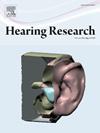Unraveling eye movement-related eardrum oscillations (EMREOs): how saccade direction and tympanometric measurements relate to their amplitude and time course
IF 2.5
2区 医学
Q1 AUDIOLOGY & SPEECH-LANGUAGE PATHOLOGY
引用次数: 0
Abstract
Eye movement-related eardrum oscillations (EMREOs) reflect movements of the tympanic membrane that scale with the magnitude and direction of saccades. EMREOs have been consistently described in humans and non-human primates, yet many questions regarding this phenomenon remain unresolved. Based on bilateral in-ear recordings in human participants we here explore several properties of these EMREOs in order to improve our understanding of this signal's origin and functional significance. Our data support that the EMREO time course is comparable between the left and right ears, and between paradigms guiding saccades by visual and auditory target stimuli. However, the precise amplitude time course differs significantly between ipsi- and contralateral saccades in addition to the previously known phase-inversion described for saccades in opposing directions. Finally, our data suggest that the EMREO amplitude is negatively related to the compliance of the tympanic membrane as established by tympanometry. Collectively, these results support the notion that EMREOs reflect motor-related top-down signals relayed to the ear from yet-to-be-resolved sources, and fuel the speculation that EMREOs may be generated by the middle ear muscles in a differential operation similar to the execution of ipsi- and contralateral saccades.
解开眼动相关的鼓膜振荡(EMREOs):扫视方向和鼓膜测量与它们的振幅和时间过程的关系
与眼球运动相关的鼓膜振荡(EMREOs)反映了鼓膜的运动,这种运动与眼球运动的幅度和方向有关。在人类和非人灵长类动物中,EMREOs 已被不断描述,但有关这一现象的许多问题仍未得到解决。基于对人类参与者的双侧耳内录音,我们在此探讨了这些 EMREO 的几个特性,以加深我们对这一信号的起源和功能意义的理解。我们的数据表明,EMREO 的时间进程在左耳和右耳之间,以及在通过视觉和听觉目标刺激引导囊视的范例之间具有可比性。然而,同侧和对侧囊视的精确振幅时间过程有显著差异,此外,之前已知的相反方向囊视的相位倒置也有显著差异。最后,我们的数据表明,EMREO 的振幅与鼓膜顺应性呈负相关,而鼓膜顺应性是由鼓室测量法确定的。总之,这些结果支持 EMREO 反映了与运动相关的自上而下的信号,这些信号从尚未解决的信号源转发到耳朵,并助长了一种猜测,即 EMREO 可能是由中耳肌肉在类似于执行同侧和对侧囊视的不同操作中产生的。
本文章由计算机程序翻译,如有差异,请以英文原文为准。
求助全文
约1分钟内获得全文
求助全文
来源期刊

Hearing Research
医学-耳鼻喉科学
CiteScore
5.30
自引率
14.30%
发文量
163
审稿时长
75 days
期刊介绍:
The aim of the journal is to provide a forum for papers concerned with basic peripheral and central auditory mechanisms. Emphasis is on experimental and clinical studies, but theoretical and methodological papers will also be considered. The journal publishes original research papers, review and mini- review articles, rapid communications, method/protocol and perspective articles.
Papers submitted should deal with auditory anatomy, physiology, psychophysics, imaging, modeling and behavioural studies in animals and humans, as well as hearing aids and cochlear implants. Papers dealing with the vestibular system are also considered for publication. Papers on comparative aspects of hearing and on effects of drugs and environmental contaminants on hearing function will also be considered. Clinical papers will be accepted when they contribute to the understanding of normal and pathological hearing functions.
 求助内容:
求助内容: 应助结果提醒方式:
应助结果提醒方式:


